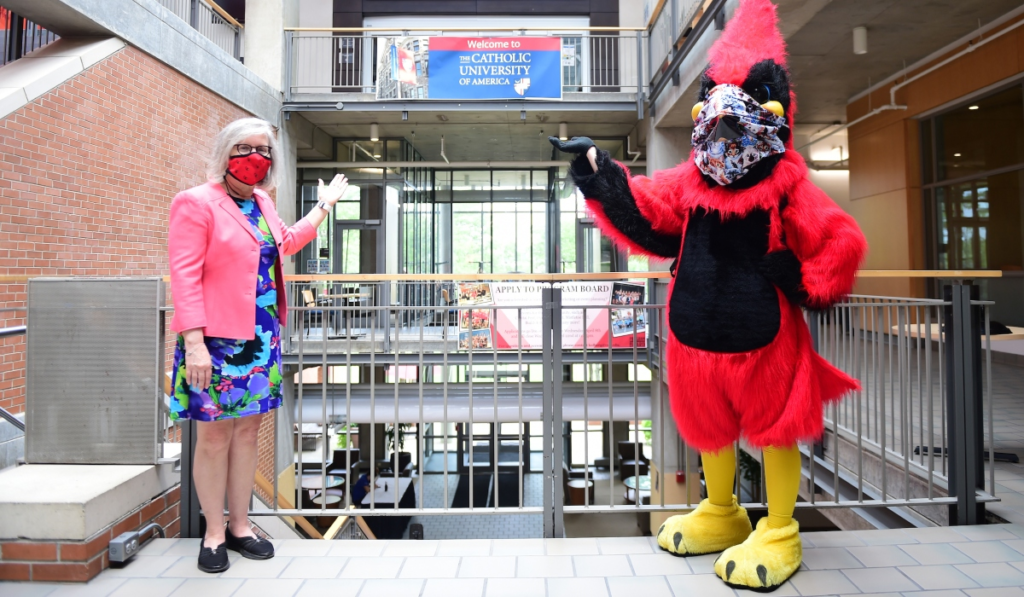As University Strives to Combat Coronavirus-Related Financial Difficulties, Faculty Fears of Wage Cuts Loom

Freshman students and transfers arrived on-campus in August with new coronavirus safety procedures. Credit
By Cristina Goerdt
2020 has demonstrated an unusual talent of stripping away life’s frivolities, from birthday parties and holiday travel, all the while exposing more pressing issues such as racism and climate change.
Much has been written lamenting the plight of university students during the coronavirus pandemic, first exploring their rapid adjustment to online learning, followed closely by heated debates over in-person versus virtual instruction for the fall 2020 semester. Students raged against lofty tuition costs and mourned the loss of community.
Similarly, press coverage has focused on the acrobatics performed by thousands of university administration officials throughout the country as the system was shoved into an existential crisis. New tech, PPE gear, testing centers, dropping enrollment, disgruntled faculty, and students: administrations scrambled to meet safety and education demands while confronting staggering losses in revenue.
At Catholic University, where officials were already heavily invested in providing a sustainable future for faculty and students, the rapid transition was nonetheless nauseating.
An email dated June 23 from President John Garvey to all faculty, staff, and emeriti faculty obtained by The Tower reveals a concerted effort by top administration officials to disrupt the functions of education as little as possible.
In the email, Garvey relates that the university had taken steps to balance the budget as early as May 19 by cutting leadership salaries, redirecting funds away from capital projects and drawing upon reserve funds to augment expenses. He reports that the measures saved at least $18 million.
The communique also outlined several measures designed to retain an additional $10.6 million in the next two fiscal years.
$8.2 million of that sum will derive from this year’s cuts, $7.4 million of which includes halting both faculty raises and matching contributions to 403(b) retirement accounts.
Similarly, a June 11 email shared with various faculty members contained a PowerPoint presentation championed by senior university leadership, including Robert Specter, vice president for finance and treasurer.
With bold red and white headers and a plethora of timelines and infographics, university strategy seems calculated and aggressive. And yet, faculty members are reluctant to speak on the record, citing the sensitivity of the subject matter.
Contrary to the veneer of consensus presented through official emails and powerpoints of outlining financial stability, the discussion board on the CUA Faculty Assembly (FA) website provides breadth and depth of conflicting opinions.
According to its website, the FA strives to stimulate “discussion and action on issues of importance” in the wider university community.
While the discussion page features numerous topics — such as the safety of students on campus and the university’s coronavirus precautionary policies — much of the talk centers on institutional viability and the perceived treatment of faculty at the hands of ranking administration officials.
Faculty and administration relations have been strained for some time. Upon hearing of the FA’s creation in 2018, the George Washington University Faculty Association sent an open letter to CUA faculty urging them “to organize, resist, and expand your opposition to faculty cuts.”
One tenured professor explained that the FA was born from conflict, forming in response to a growing sense of exclusion between administration and wider faculty; that is, those not serving on the Academic Senate, Committee for Faculty Economic Welfare, or other such bodies.
Although wage cuts have not been formally proposed, the fear runs rampant. “I continue to worry about the impending pay cuts,” one anonymous user wrote on September 13.
Other anons jumped in to voice their agreement. “The poor [freshman] enrollment this year will have a carryover effect for the next 4 years…I have little confidence the leadership is equipped to deal with the crisis,” one faculty member wrote.
Another added, “I think the retirement match is gone for good, but they [administration] are going to need more. The cuts are a given.”
Anxiety rolls off of the message board in waves, washing over national rankings, the safety of students on campus, and perceived re-alignment of the university with certain political values. A mistakenly distributed letter of Academic Renewal contained a clause that appeared to imply the provost retained the right to fire tenured faculty without due cause, which is illegal.
The letter was later rescinded, but the disquietude remained. Declared a “top priority” by Garvey in his June email, many now doubt when the raises will come, if at all.
According to Garvey, $1.7 million had been allocated in the 2020-2021 budget to pay for raises. However, a Financial Planning, Institutional Research and Assessment document states that the university employed 367 faculty.
If the $1.7 million were to be divided equally among all faculty members, each would receive a total approximating to $4,632. Such a sum seems meager when one recalls that Catholic University faculty have not received a raise in at least a decade in a city where the cost of living increases by 2% a year.
Karna Lozoya, Executive Director of Strategic Communication, said that in addition to measures outlined by President Garvey, the university “recently closed out our interest in a property on Varnum St. for $4.5M.”
Furthermore, the administration is “giving serious consideration to an eco-friendly development of the property west of Harewood Rd.”
In an interview, Provost Aaron Dominguez stressed the four principles that have guided the financial restructuring process: the health and safety of the community, continued viability of the institution, educational quality, and preserving jobs.
“No one was expecting this,” he said, saying that he thinks leadership has been “adjusting heroically” to the sudden stress.
Dealing with the crisis has been “the hardest thing I’ve ever done,” said Dominguez.
When asked about the possibility of wage cuts, though, Dominguez seemed to falter slightly.
“We will at some point — with enough bad luck” institute wage cuts, he said, adding that their top priority has been preserving jobs at a time when unemployment in the United States is at a record high.






